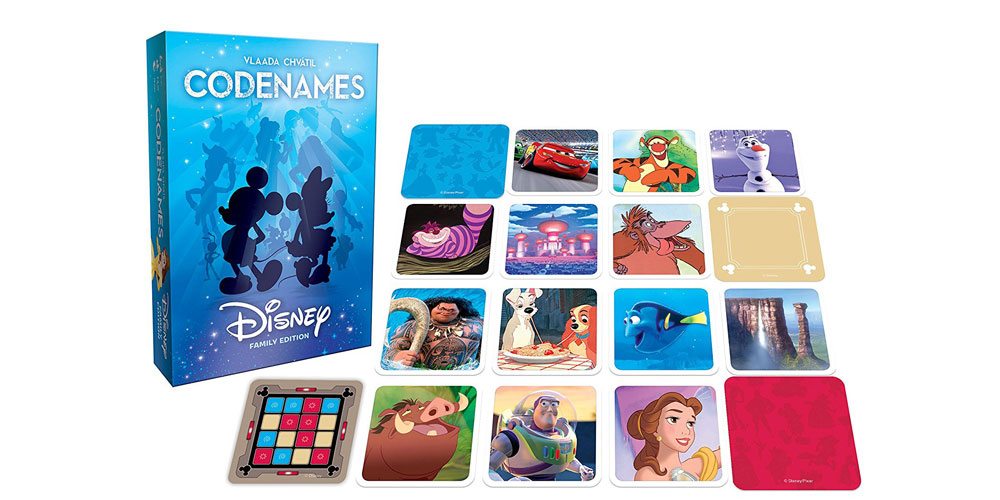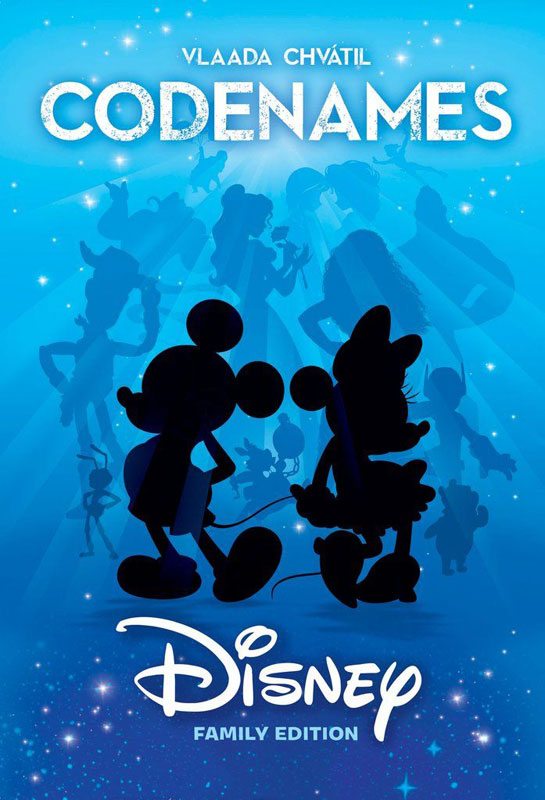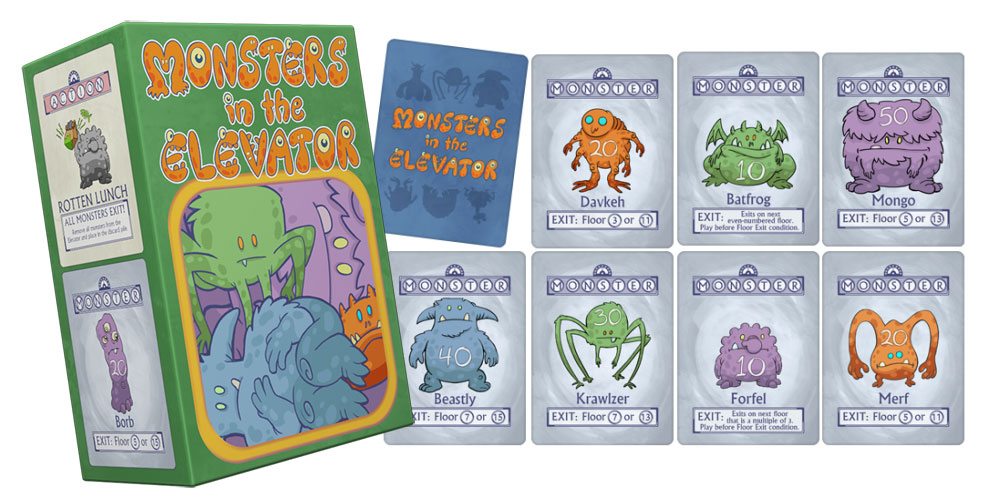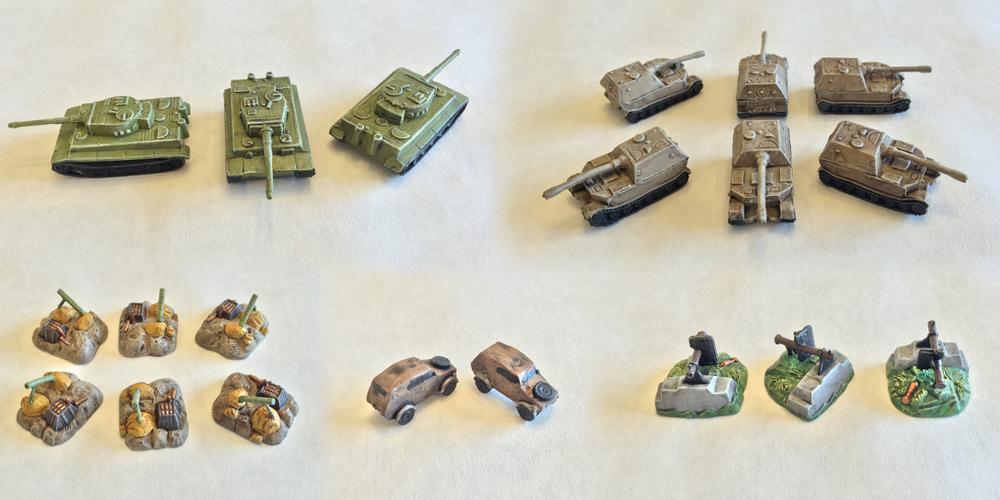Codenames: Disney Family Edition brings the whole magical world of Disney to one of our favorite games, with some tweaks to make the game friendlier for even younger players.
What Is Codenames: Disney Family Edition?
Codenames: Disney Family Edition is a competitive team game for 2 to 8+ players, ages 8 and up, and takes about 15 minutes to play. (The game is for two teams, so ideally you want 4 or more players, but there are variant rules for 2 and 3 players.) It retails for $24.95 and is available now in stores and online. The “8 and up” age rating is what’s on the box, but really with this edition you can play with even younger players, too.
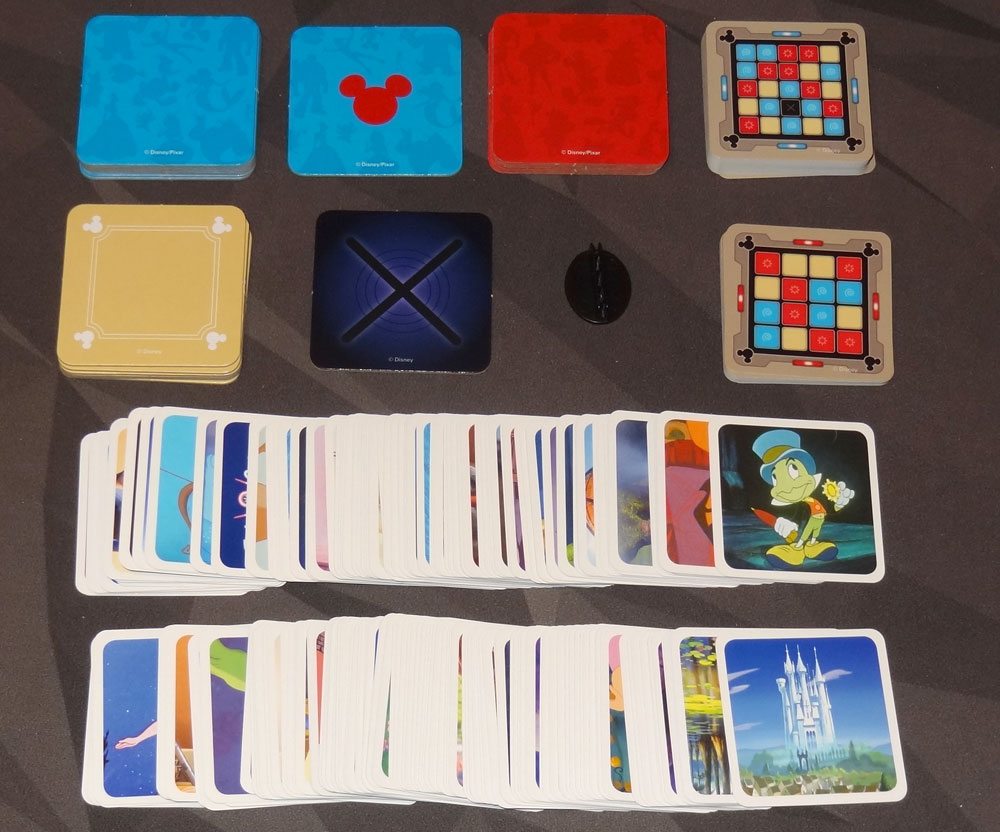
Codenames: Disney Family Edition Components
- 200 Treasure Cards
- 60 Key Cards (20 Easy, 40 Advanced)
- 25 Cover Cards (8 Blue, 8 Red, 7 Tan, 1 Extra, 1 Game Over)
- 1 Card Stand
The components in this edition are similar to Codenames Pictures, with square cards and covers. However, the treasure cards have images on one side, all from Disney animated films, and corresponding words on the other. The majority of the images are characters—ranging all the way from Snow White and the Seven Dwarves up to Moana, including all the Pixar films as well. There are also images of other things like objects and locations. You’ll definitely want to give the whole stack a very good shuffle before you play, because the cards are initially organized by movie so you’ll get a whole batch of Finding Nemo cards all at once, for instance.
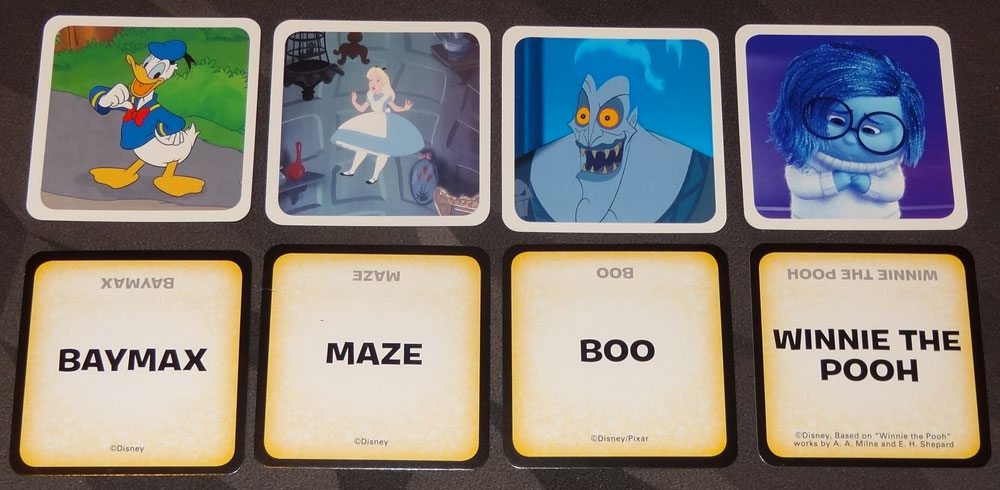
As with the original game, the word side of the treasure cards includes the word very large facing one direction, and then a smaller copy of the word upside-down so that the clue-giver can read them. The font is such that the smaller version is still easy to read, but I still find that whether I’m guessing or giving clues, I’m more likely to look at the bold large text than the smaller grey text. The word side also has “©Disney” at the bottom, and sometimes other information as well, like “Pixar” or a long string of text about Winnie the Pooh—but those are printed fairly tiny. (If you primarily use the picture side for the game, though, none of this really matters anyway.)

The easy key cards show a 4×4 grid, with each space colored red, blue, or tan; the advanced key cards are more like those of the original version, with a 5×5 grid, and these also include one square with a black X. Each card also has either red or blue bars along the borders. There are some Mickey Mouse heads on the corners, and the symbols distinguishing red and blue squares are also a little different from the original—swirls and starbursts—but otherwise they look really similar to the original game’s key cards.
The cover cards are just red and blue, with silhouettes of various Disney characters on them. The extra cover card red with a blue Mickey on one side, and blue with a red Mickey on the other.
How to Play Codenames: Disney Family Edition
The gameplay remains the same as the original edition, so if you’re already familiar with Codenames you can skip to the next section. This section assumes you’ve never played before, and starts with rules for the easy version first.
The Goal
The goal of the game is to find all of your treasures before the other team does.
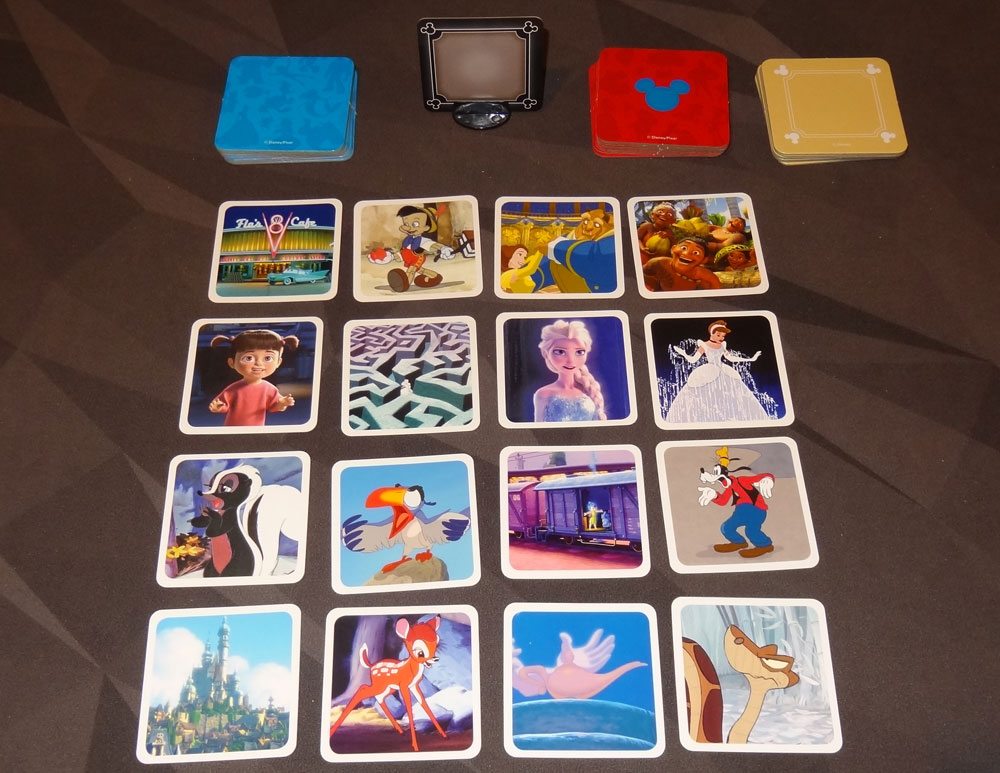
Setup
Split up into two teams; each team will need to have one cluemaster (clue-giver) and the rest of the players are guessers. The cluemasters sit together on one side of the table, and everyone else sits across from them.
Shuffle the treasure cards and lay out a 4×4 grid. You can choose whether to use the pictures, the words, or a mixture of both, but the cards should be oriented toward the guessers.
Draw a random key card and place it on the stand so that only the cluemasters can see it. Each team takes its stack of cover cards, with the neutral covers placed nearby. (You will not need the game over cover—that’s used in the advanced rules.) The team whose color appears in the color bars on the key card will go first, and they also take the extra cover card and flip it to show their team color. (Note: the starting team has 6 treasures to find, and the other team has 5 treasures.)
Gameplay
The two teams take turns playing. During a turn, the cluemaster must give a one-word clue followed by a number, indicating the number of the team’s treasures that match that clue. For instance, you might say “underwater 2” to get your teammates to guess Dory and Ariel—assuming that there aren’t other underwater clues that belong to the other team!

Then the guessers may discuss the clue, finalizing their guesses by touching the treasure cards one at a time and waiting for the cluemaster to confirm. If the card touched belongs to the guessing team, the cluemaster places their own cover card on it, and the team may continue guessing. If the card touched belongs to the other team or is a neutral card, the corresponding cover card is placed on it and the turn ends.
Note that the cluemasters are supposed to keep a straight face and provide no information whatsoever aside from the single word and number. The rules even suggest that the guessers do not make eye contact with the cluemasters.
The number of guesses a team is allowed to take is one more than the number given by the cluemaster. So if the cluemaster said “apple 2,” the team could take up to 3 guesses, as long as the first two are both correct. This comes into play later in the game, when teammates have missed guesses on previous turns—they can use these extra guesses to catch up on old clues as well.
There are a few advanced clue rules that can be introduced as well. “Clue: Unlimited” allows the team to make as many guesses as they want (as usual, they must stop if they make an incorrect guess). It can be helpful for making up lost ground when the team has gotten many incorrect guesses in previous turns. “Clue: Zero” is an opposite clue—it also allows the team to make unlimited guesses, but means that the team’s cards are not related to the clue. For instance, “Animal: Zero” means that any cards pertaining to animals are not supposed to be guessed.
Game End
If you cover up all of your treasures first, you win the game!

Advanced Rules
The advanced version uses the 5×5 key cards, with a corresponding 5×5 grid of cards for the setup. There is a black “X” on one of the squares on the key card, which is the game over square. If your team guesses the game over square, the game ends immediately and your team loses. When giving clues, you’ll have to be careful not to give a clue that will connect to that particular card.
In the advanced version, the starting team has 9 treasures to find and the other team has 8 treasures to find.
2-Player Variant
For two players, you both play on the same team, with one player as cluemaster and one as guesser. After each turn, the cluemaster places one of the opposing covers on a card. To win, you must cover all of your treasures before all of the opposing treasures are covered—your score is based on how many opposing covers are left when you finish.
3-Player Variant
Two players serve as cluemasters, and the third player is an guesser for both teams, guessing as well as they can for all the clues. The cluemaster who covers their treasures first wins.
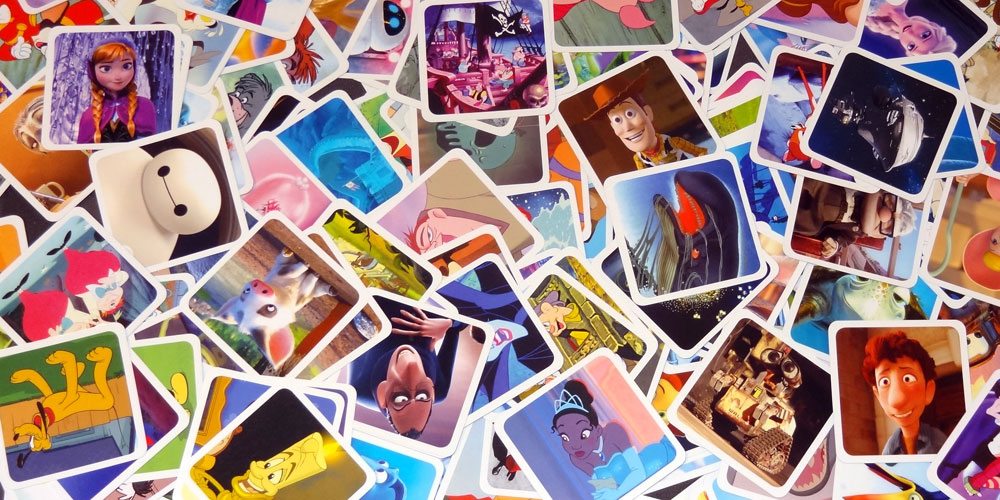
What’s New in Codenames: Disney Family Edition
If you’re already familiar with Codenames, then there’s not a lot of rule changes in this version. The terminology is slightly different: codename cards are now called treasures, spymasters are called codemasters, and bystanders have become neutral cards. The assassin is now the “game over” square.
The primary difference is the introduction of the easy key cards, which have a 4×4 grid and no “game over” square to make it easier for younger or less experienced players. The “advanced” version in the Disney Family Edition is equivalent to the regular rules in the original Codenames.
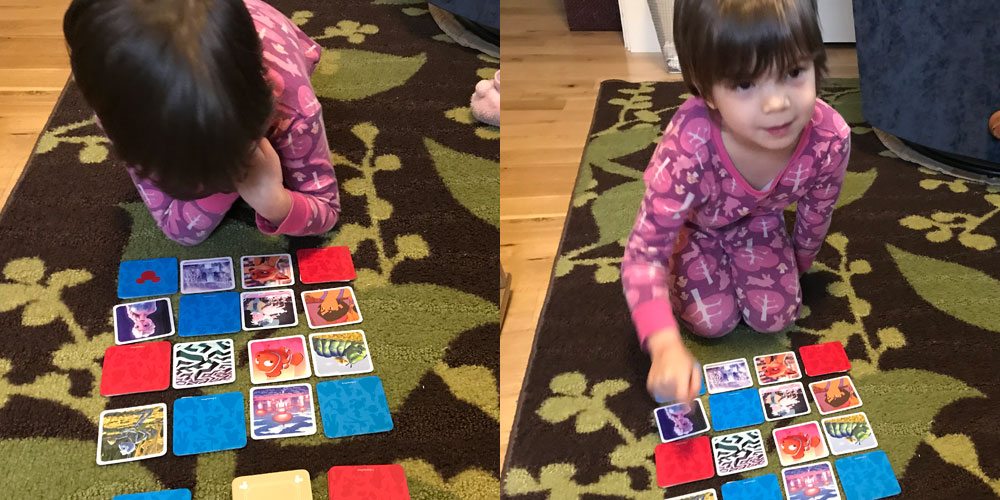
Why You Should Play Codenames: Disney Family Edition
This version of Codenames doesn’t just say “Disney” on the title—the “Family Edition” is there for a good reason. Sure, if you’re a fan of Codenames and you love Disney movies, this one is also for you. But the real change is in the easy key cards: the combination of a smaller card grid and familiar characters makes this edition a great choice for families with younger kids. My older kids love Codenames, but now my four-year-old has gotten a chance to play, too. She was even able to be the cluemaster, though typically with just single-card clues on each turn.
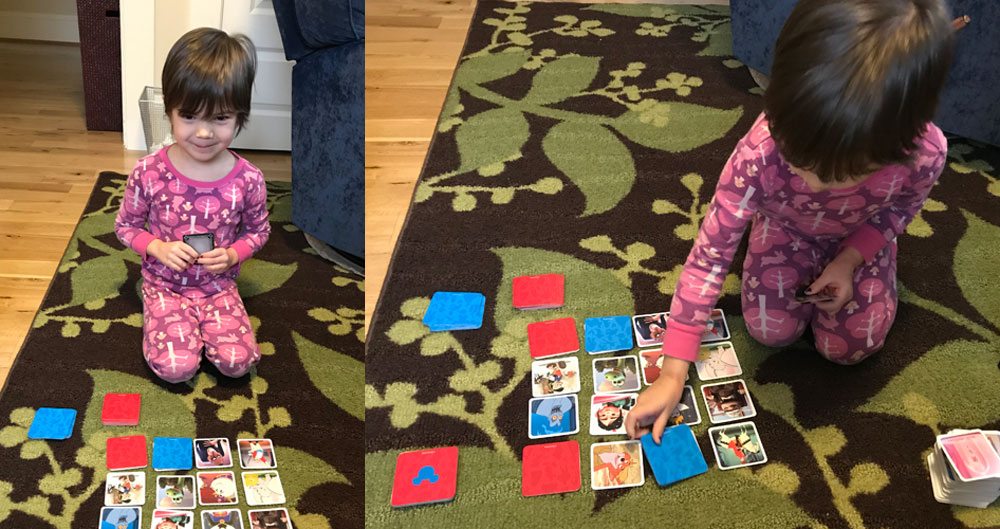
Other than that, Codenames: Disney Family Edition is about what you should expect: the same great game, but Disney-fied. I love the fact that it includes such a huge breadth of films. While flipping through the cards, I found myself playing my own version of Disney Timeline, trying to put the films in chronological order. Another bonus, if you have kids who know their Disney characters but are still learning to read, is that the cards can serve as reading flash cards, too—you could really do quite a bit with these cards in addition to playing Codenames.
Lest you think it’s just for little kids, though, rest assured that the game can still be a challenge for adults. You may not recognize all of the characters and scenes on the cards, but you can still give clues that connect based on the images: you might be able to connect Robin Hood with Nick from Zootopia, for instance, or group some images from the same film, or pick out a color or other feature (and hope that your guessers are paying attention to the details).
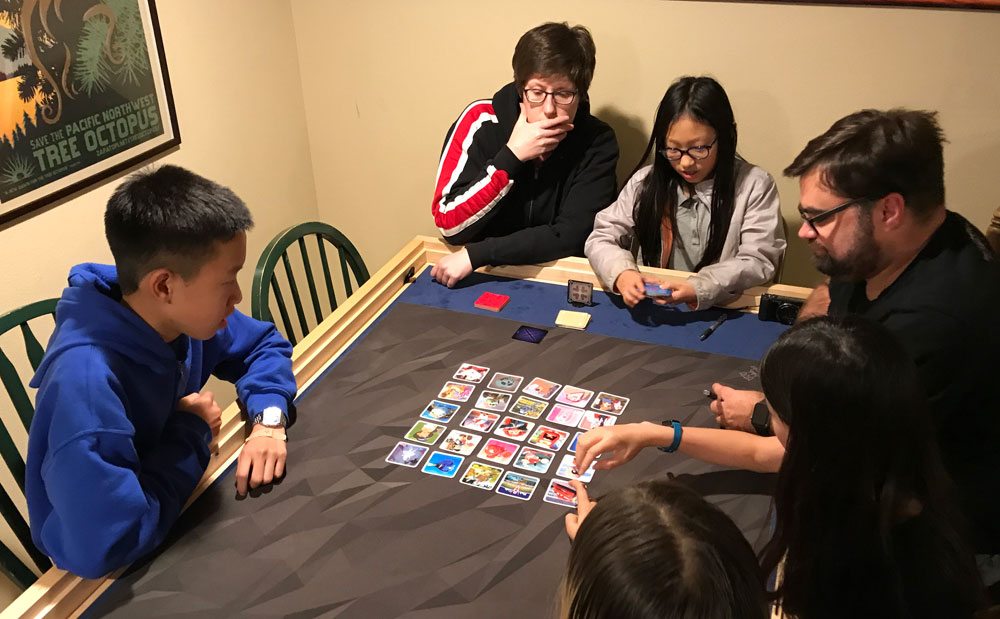
For me, at least, this version (even using the advanced key cards) is a little more accessible than Codenames: Marvel, simply because I recognize more of the images, though your mileage may vary. All in all, I think Codenames: Disney Family Edition would be a great fit for any Disney fan who also loves guessing games.
Click here to see all our tabletop game reviews.
If you’d like to stay up-to-date with all of our tabletop gaming coverage, please copy this link and add it to your RSS reader.
Disclosure: GeekDad received a copy of this game for review purposes.
